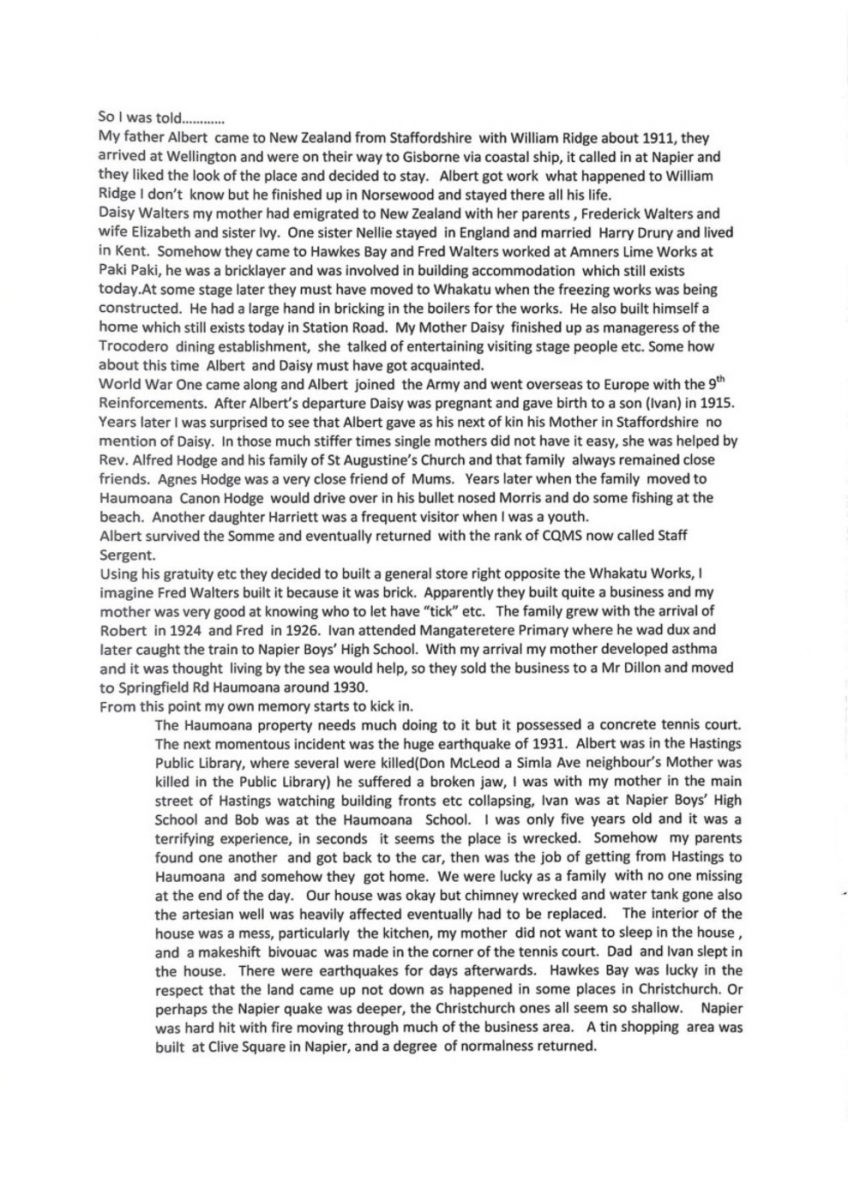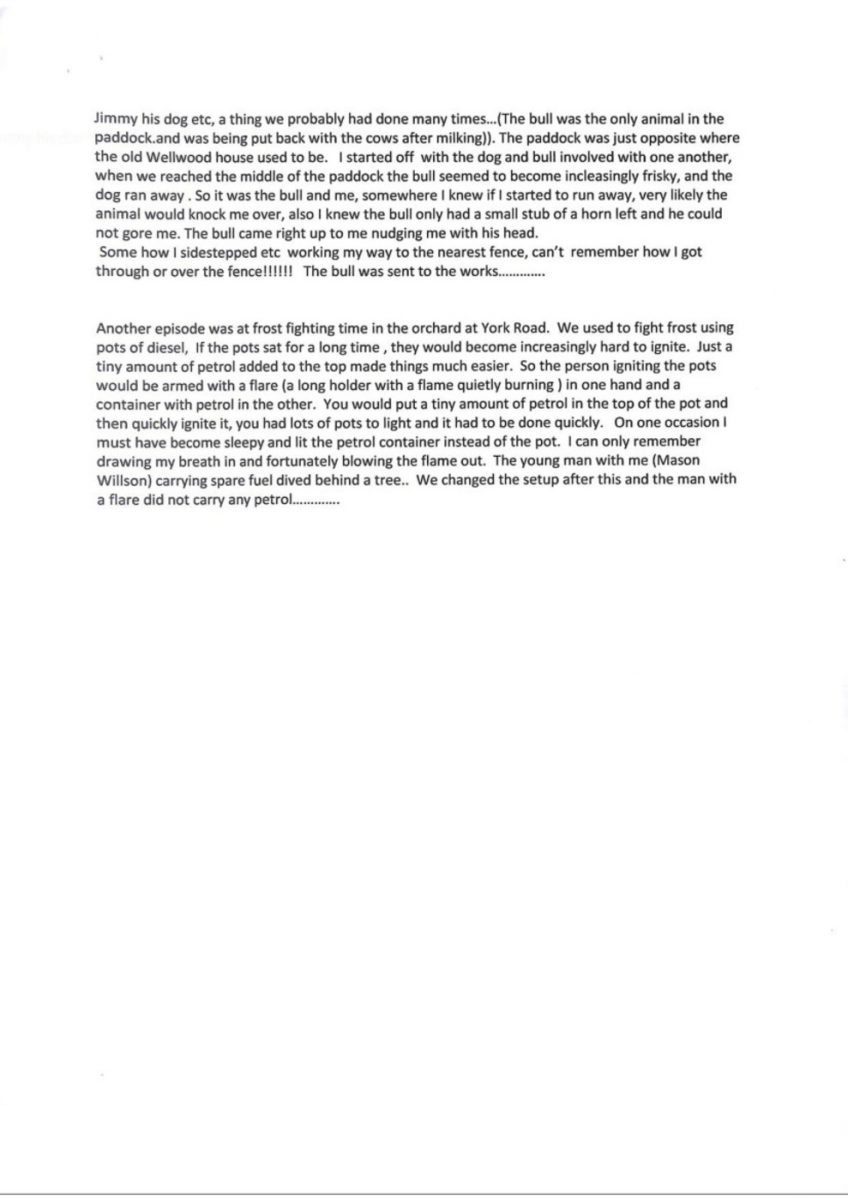Page 2
Ivan gained University Entrance with Medical Perlim.[Prelim.], did not use that and won a job in accountancy with McCulloch Butler and Spence in Hastings. He played tennis and met Jean Burge in club matches, at this stage there was a family quarreI and he left home. Bob spent a couple of years at NBHS, his horticultural interest was not covered and it was organised that he would do a diploma via studies using Victoria University. He had done the first stages when at the age of 18 he went into the Air Force as a trainee aircrew candidate. He went to Levin and Taiere and was then shipped to Canada, on the completion of his course he gained a commission and became a bomb aimer on Lancaster type aircraft. Ivan suffered from asthma and he gave up accountancy and went on the land as a shepherd, working for Pat Barker on a Te Aute trust farm. Eventually Ivan married Jean, he had to change jobs to get a job with accommodation and finished up at Craggy Range station. I used to bike up the Tuki Juki [Tuki] Road to Craggy Range, sometimes stayed with them, it was wonderful as a horse would be provided and I could accompany Ivan on jobs around the station. It was a big place of several thousand acres, I remember one paddock being named the drome because Piet van Ash [Asch] would land his plane there.(he was the founder of Aerial Mapping.) Ivan and Jean had a little Austin 7 and their first child (Barbara) had arrived. When they put her pram on the back of the car it was nearly as big as the car. Somewhere in this period Ivan went into the Army, but did not stay long invalided out because he was a severe asthmatic. At this stage Ivan must have decided that knowledge of dairy farming was essential if he was going to progress and he decided to go to Taranaki and get experience of that sort of farming. He got a position on a farm owned by W. Freeth and learnt the key elements of dairying. This was in the 1940s. Albert and Ivan patched up their relationship, and Pa eventually purchased the property in York Road, it was owned by Ernie Wall a leading pig farmer, 43 acres with access to Kaiapo Road. Thirty cows and a Jersey Bull were purchased from Hughie McKeesick, Tuki Tuki Road near Haumoana, (this is the bull that became very aggressive and I had an episode with) Around this time I must have joined Ivan and my farming career began. The farm had large pig farming facilities, Ivan organised it as a conventional diairy farm, a draught horse was the only other animal on the farm. I guess the locals watch proceeding with great interest, the immediate properties on either side were the Pimley Family, and Wellwood estate at the end of York Road
York Road of course at that stage was a lovely blind road, with yards at the end which were part of the Annie Wellwood property, a property which Ivan would later lease to increase his herd to 70 cows. Being wartime getting gear together was difficult, the first tractor was a Model B Allis Chalmers on steel wheels, it was a great day when we got rubber tyred wheels for it. You started it by cranking, I had six weeks off when the impulse somehow got mixed up and it broke my arm. The Herd Tester came regularly and that way you soon knew which were the better animals. We separated the milk and the cream went to the Heretaunga Dairy Co at Stortford Lodge, the truck came to us fairly early so it had to be at the gate by 7.30 am. We had pigs fed with the skim milk, one large white sow had 16 piglets and we raised them all, a Borthwicks rep (Jim McCormick) used to take all our pork production, and the pigs had a nice grass paddock. I lived with Ivan and Jean and Marie must have been on the scene. Can remember Ivan telling me Jean was pregnant again with John. I had a little James 2 Stroke about 125 cc I think, and used to go to Haumoana on that, came off it just on the Haumoana side of Black Bridge must have followed a truck carrying sawn firewood blocks, it was nearly dark and a piece of wood was on the road caught the exhaust pipe and I veered across the road near a girl waiting for a bus and into the fence.
In October 1944 (Vin Morris, Local Postmaster, Haumoana called with a telegram) we got the shocking news that Bob had been killed,aged 20.
What a great brother he had been for me and what a waste to die so young . My mother was a different person after that, I don’t think she ever really got over it. My father said he would try and block me going into the services until I was 21. I think milking cows was classed as an essential industry and I was 19 when the war finished. Albert spent most of the war in the National Guard, he had the rank of sergeant he was in charge of a small detachment of men guarding the petrol tanks at Ahuriri. Cannot clearly remember when we grew our first paddock of peas for Watties.















Do you know something about this record?
Please note we cannot verify the accuracy of any information posted by the community.